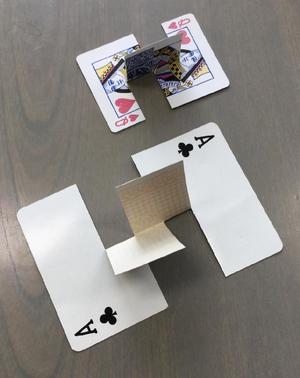
Impossible Folding Font |
by Erik Demaine, Martin Demaine, Tomoko Taniguchi, and Ryuhei Uehara, 2019 |
|
|

Impossible objects are physical objects that obviously exist yet appear to be impossible; see, for example, Sugihara's award-winning collection. One elegant form of the impossible object is the hypercard, popularized by Martin Gardner in 1978. Hypercards are typically made from one complete playing card or index card, and yet seem to be impossible; see the figure on the right.
Each letter and numeral in this typeface is represented by a one-flap impossible folding or hypercard. In our designs, we use a square sheet of paper with crease lines on horizontal, vertical, and 45° diagonal lines. Each folding angle is orthogonal, that is, ±90° or ±180°.
Why do these objects seem to be impossible? One reason is that the sheet has been twisted, and twisting is necessary to form the 3D shape, while the resulting folded state does not seem to be twisted. A key feature of the folded state is a vertical flap extending from a horizontal plane (shaded darker in the folded form), with the property that the vertical flap overlaps other material when rotated in either direction onto the horizontal plane, thus seeming to be impossible from a single sheet of material.
This typeface consists of two main fonts: the folded 3D form and the unfolded cut/crease pattern. Each folded 3D form is an impossible-object puzzle: how can it be cut/folded from a square of paper? Each cut/crease patterns is also a (straightforward) puzzle: what letter/numeral does it fold into? To reveal the solutions to both puzzles, you can display both fonts side-by-side using the “both” font. By default, we render all letters in upper case (because these letters have been more carefully design to have correct heights); if you want to include lower-case letters, please check the box.
If you'd like to see animations of the folding process (which really helps show the twisting that happens), try the "Simulate in Origami Simulator" button. (This currently works best with just a single letter.) Alternatively, download one of the following SVG cut/crease patterns and load them into Origami Simulator: . You can also print these out to try making an impossible object yourself. Red lines are mountain folds; blue lines are valley folds; lighter lines fold 90° while darker lines fold 180°; and green lines are cuts.
For more about this typeface and hypercards in general, see our paper “Impossible Folding Font” at BRIDGES 2019.
Check out other mathematical and puzzle fonts. • Feedback or not working? Email Erik. • Source code on GitHub.